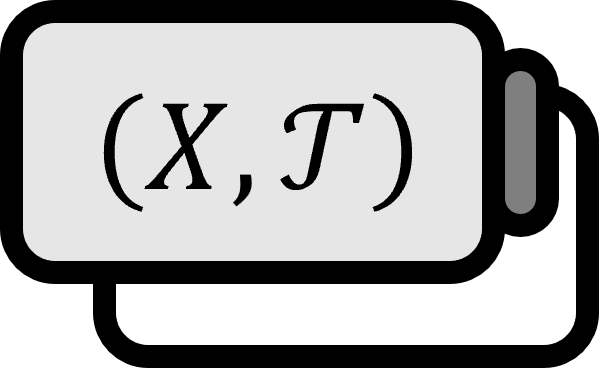Functional Spaces in Topology
Definition 1
A function space is defined as the product space $Y^{X}$ for topological spaces $X$ and $Y$. $$ Y^{X} : = \prod_{x \in X} Y = \left\{ f \ | \ f : X \to Y \text{ is a function} \right\} $$
The topology for the function space can be:
- For an open set $U$ in $x \in X$ and $Y$, let $$ S (x , U) = \left\{ f \in Y^{X} \ | \ f(x) \in U \right\} $$ The topology generated by the subbasis $\left\{ S(x,U) \ | \ x \in X , U \subset Y \right\}$ for $Y^{X}$ is called the Point-Open Topology.
- For a compact set $K \subset X$ and an open set $U$ in $Y$, let $$ S (K , U) = \left\{ f \in Y^{X} \ | \ f(K) \subset U \right\} $$ The topology generated by the subbasis $\left\{ S(K,U) \ | \ K \subset X , U \subset Y \right\}$ for $Y^{X}$ is called the Compact-Open Topology.
Let’s say $(Y,d)$ is a metric space.
- For a compact set $K \subset X$ and $\varepsilon > 0$, let $$ B_{K} (f, \epsilon) = \left\{ g \in Y^{X} \ \left| \ \sup_{x \in K} \left\{ d(f(x),g(x)) \right\} < \varepsilon \right. \right\} $$ The topology generated by the basis $\left\{ B_{K} (f, \varepsilon ) \ | \ K \subset X , \varepsilon > 0 \right\}$ for $Y^{X}$ is called the Topology of Compact Convergence.
- The uniform metric $$ \overline{ \rho } (f,g) : = \sup_{x \in X} \left\{ \min \left\{ d(f(x) , g(x) ) , 1 \right\} \right\} $$ generates the topology for the metric space $(Y^{X} , \overline{ \rho } )$ called the Uniform Topology.
Theorem
- [1]: The Compact-Open Topology is larger than the Point-Open Topology.
- [2]: The Topology of Compact Convergence is larger than the Point-Open Topology.
- [3]: The Uniform Topology is larger than the Compact-Open Topology.
- [4]: The Uniform Topology is larger than the Topology of Compact Convergence.
- [5]: If $X$ is a discrete space, the Topology of Compact Convergence for $Y^{X}$ is the same as the Point-Open Topology.
- [6]: If $X$ is a compact space, the Topology of Compact Convergence for $Y^{X}$ is the same as the Tychonoff Topology.
Let $\left\{ f_{n} : X \to Y \right\}$ be a sequence in $Y^{X}$, and let the function restricted to the domain $K \subset X$ be denoted as $f_{n} |_{K} : K \to Y$.
- [7]: If $\left\{ f_{n} \right\}$ converges to $f$ in the Point-Open Topology of $Y^{X}$, then for every $x \in X$, $ f_{n} (x) $ converges to $f(x)$.
- [8]: If $\left\{ f_{n} \right\}$ converges to $f$ in the Topology of Compact Convergence of $Y^{X}$, then for every compact $K \subset X$, $f_{n} |_{K}$ uniformly converges to $f |_{K}$.
For a set of continuous functions whose domain is the topological space $X$ and codomain is the metric space $Y$, $$ C(X,Y) := \left\{ f \in Y^{X} \ | \ f \text{ is continuous} \right\} $$ and let $C(X,Y)$ be a subspace of $Y^{X}$.
- [9]: The Compact-Open Topology and the Topology of Compact Convergence for $C(X,Y)$ are the same.
- [10]: The Topology of Compact Convergence for $C(X,Y)$ does not depend on the distance function of $Y$.
- [11]: If the sequence $\left\{ f_{n} \right\}$ of $C(X,Y)$ converges to $f \in Y^{X}$, then $f : X \to Y$ is a continuous function.
Explanation
In particular, $C(X, \mathbb{R})$ is represented as $C(X)$, and especially when $X$ is an interval, that is, when $X=(a,b)$, $X=[a,b]$, they are represented as $C(a,b)$, $C[a,b]$, respectively.
[1]~[4]
To summarize, one can say the Point-Open Topology is smaller, and the Uniform Topology is larger.
[7], [8]
It can be useful in demonstrating uniform continuity of functions.
[10], [11]
As a generalization of analysis to general topology, this is very important as a fact.
Munkres. (2000). Topology(2nd Edition): p267. ↩︎
